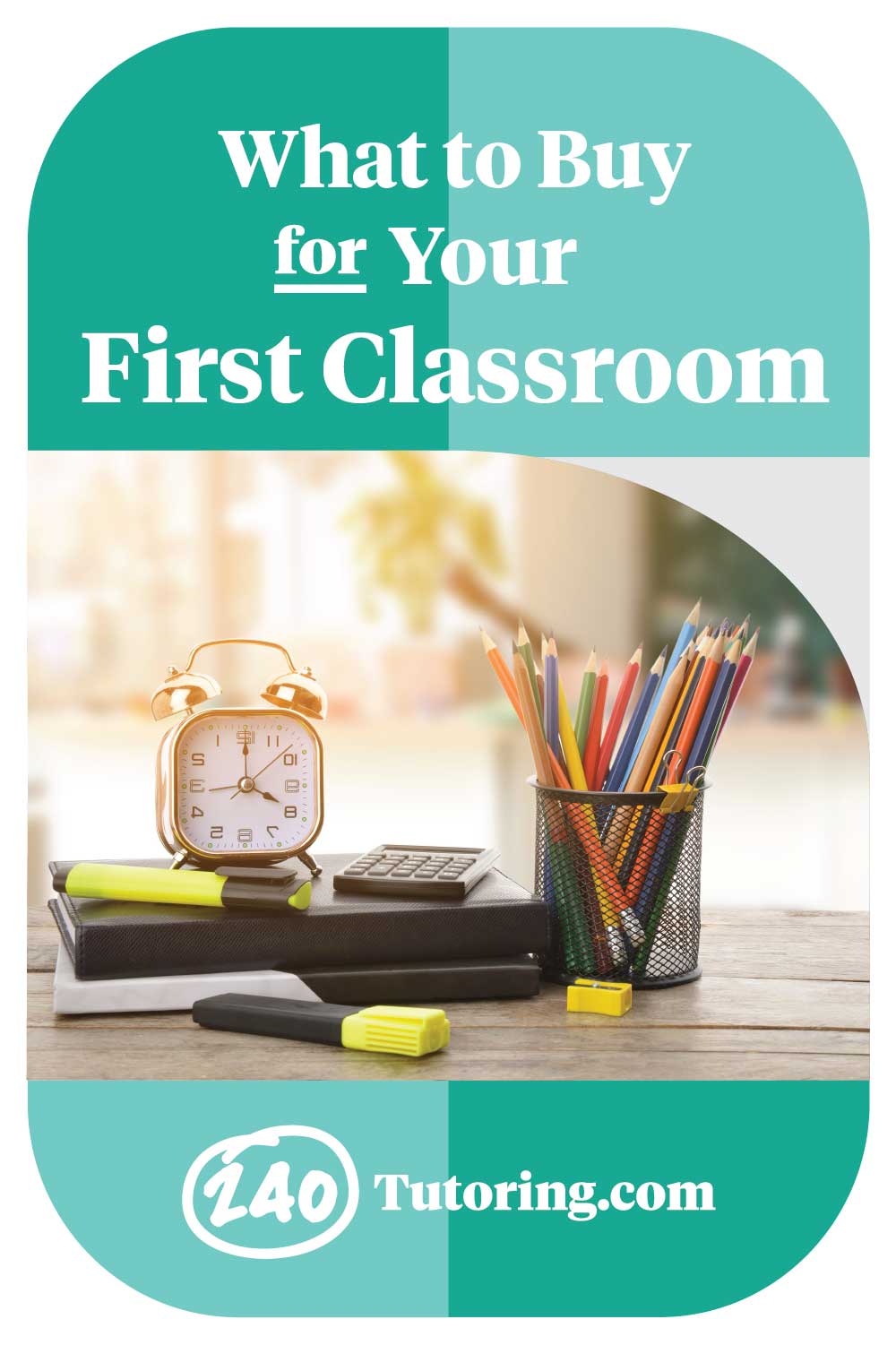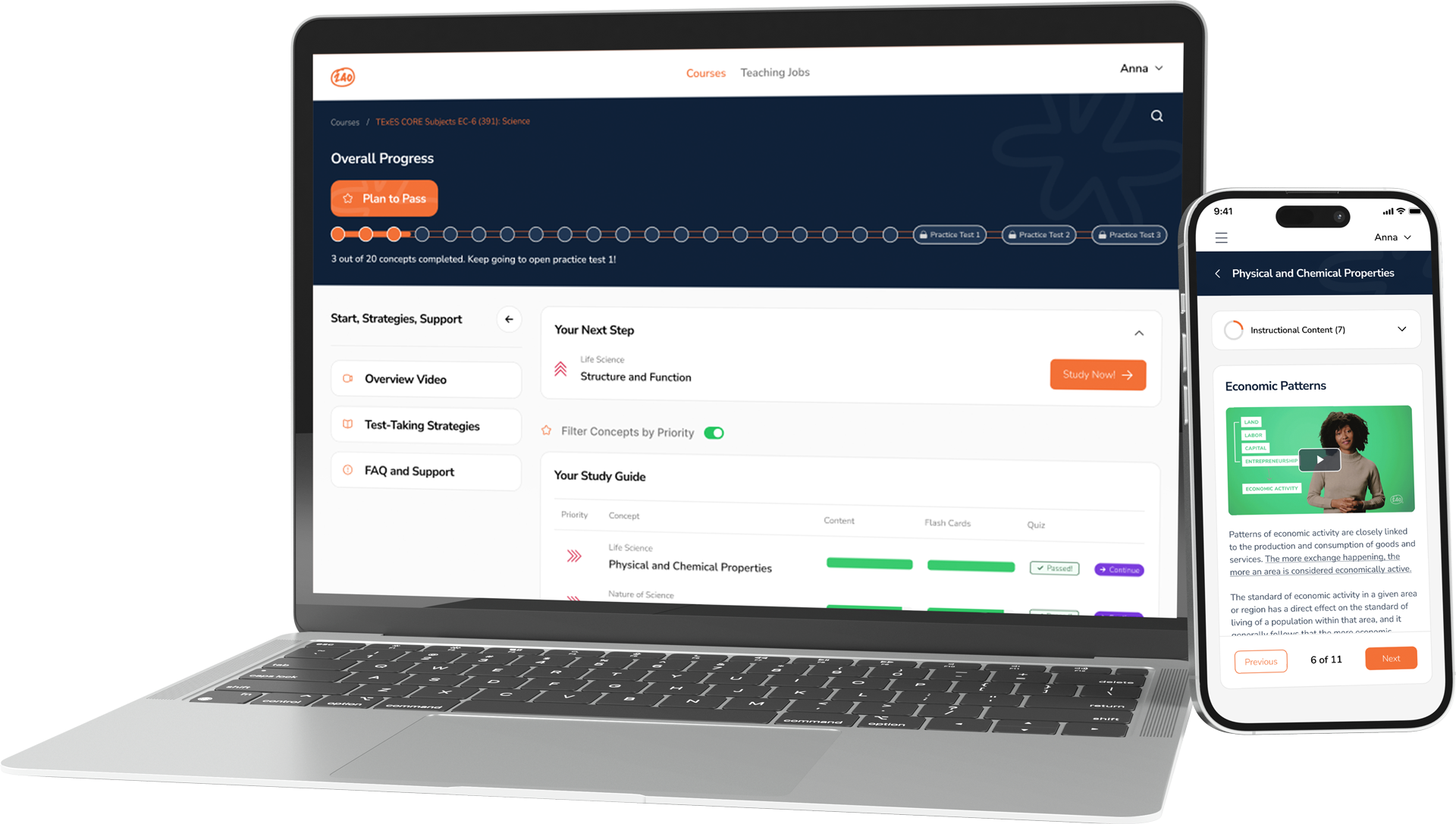Not sure where to start? Let us help! 💪
I'm a teacher candidate at a university/college I'd like to transition to teaching I'm a current / former teacher I'm in leadership for K-12 or Higher Ed (EPP)What You Need to Buy for Your First Classroom

 Getting your first classroom ready can be overwhelming and expensive – especially when you probably haven’t even gotten your first paycheck yet! But at 240 Tutoring, we’re here to help. We have over 60 years of collective experience teaching students in the classroom and developing curriculum for educators.
Getting your first classroom ready can be overwhelming and expensive – especially when you probably haven’t even gotten your first paycheck yet! But at 240 Tutoring, we’re here to help. We have over 60 years of collective experience teaching students in the classroom and developing curriculum for educators.
We’ve created a comprehensive list of things a first-year teacher needs for the classroom, as well as some money-saving tips to make your classroom preparation less pricey.
In this article, we will cover:
- First-Year Teacher Classroom Checklist
- Ways to Save Money on Your First Classroom
- What NOT to Buy for Your First Classroom … Yet
First-Year Teacher Classroom Checklist
As you may have already suspected, this list is long. But don’t stress just yet! Several of these items may be provided by the school or included in your students’ school supply lists. Other items may not be necessary based on your own preferences, plans, or organization style. However, we wanted to go ahead and give you a complete list so that nothing gets overlooked.
Keep in mind that several of the items below won’t be needed for middle school or high school classrooms. For example, easels and large rugs are often used in lower elementary grades but would likely not be needed for upper elementary grades or higher.
Teaching Tools and Resources
- Math manipulatives (foam dice, pattern blocks, unifix cubes, base ten blocks, pretend money, etc.)
- Class set of small dry erase boards
Tip: Visit a hardware store and ask for “shower board” or “white tile board.” They will cut this into smaller sizes for you at little to no extra cost. Tape the rough edges with colorful duct tape, and you have a DIY set of personal dry erase boards!
- Dry erase markers, both fine-tip and traditional chisel-tip
- Felt or cloth to be used as erasers
- Gradebook (Yes, all grades will be recorded on a computer program, but you still need to keep a hardcopy of grades.)
- Books
Tip: Don’t focus on one grade level. You’ll have students reading at a variety of levels, and you may not teach the same grade in future years. Aim for a variety of reading levels ranging from about two to three grade levels above and below your grade.
- Calendar
- 100s chart
- Large number line
- Alphabet poster or alphabet line
- Variety of pocket charts (check with other teachers in your grade level to see which ones they use most frequently)
- Chart paper
- Easel
Student Supplies
Most of these items will be on the students’ school supply lists, but it can be helpful to have a few extra sets on hand.
- Pencils
Tip: No matter how many pencils your students come with, you’ll still need more. Don’t skimp on quality – you’ll just end up frustrated when the pencils keep breaking, or worse, when they break your pencil sharpener.
- Markers
- Crayons
- Lined paper
- Construction paper
- Erasers
- Glue sticks
- Highlighters
- Scissors
- Rulers
Centers and Station Supplies
- Heavy-duty page protectors or “dry erase pocket sleeves” (These are great for creating reusable activities. Print an activity onto cardstock, slip it into the page protector, and it can be used over and over again with dry erase markers.)
- Cardstock
- Plastic bins in a variety of sizes
- Clip boards
- Ziplock bags in a variety of sizes
- “Pretend play” items for early childhood grades (play food, dress up clothes, etc.)
- Literacy centers supplies: sentence strips, sight word flash cards, magnetic letters and magnet boards, phonics games, etc.
- Math center supplies: foam dice, dominos, math spinners, counters, etc.
Organization and Basic Office Supplies
- A quality electric pencil sharpener
- Magnets (Magnetic clips work great.)
- Pens
- Pencils
- Highlighters
- 3 hole punch
- Rolling drawer cart
Tip: These often go on sale at major craft stores. If you can’t find one on sale, ask about coupons or teacher discounts.
- File folders, including hanging ones
- Binders
- Folders
- Notebooks
- Hanging pocket charts for file folders
Tip: This is a great space-saving way to organize student papers
- Paper clips
- Binder clips
- Stapler and staple remover
- Tape
- Supply caddies for student tables
Tip: Dollar stores often have good options for this.
- Various paper trays for turning in assignments, storing paperwork, organizing construction paper, etc.
- Sticky notes
- Planner
Classroom Setup and Decor
- Bookshelves
- Book bins or plastic containers to organize your classroom library (Cardboard magazine holders can work for now, but eventually you’ll want to splurge on something more durable.)
- Inexpensive curtains
- Floor lamp
- Inexpensive rug
- Job chart
- Daily schedule poster
Tip: Job charts and daily schedule posters can be created yourself or purchased as printable files from sites such as Teachers Pay Teachers.
- Bulletin board borders
Tip: ask other teachers if they have extra!
- A box or crate for students to turn in daily take home folders (more common in early elementary grades)
- Command strips and hooks
- Flexible seating options such as cushions, stools, or an old couch
Other
- Hand sanitizer and disinfectant wipes
- Tissues and paper towels (often included in students’ school supply list)
- Extension cords and power strips
Worried You Might Be Forgetting Something? Look at Other Teachers’ Classrooms!
This is a great way to get ideas for your first classroom and to find items that you may have overlooked. Ask a few teachers in or near your grade level to show you around their room and explain how they set up their classroom. Take note of different stations or centers, where certain materials are placed, filing and organization systems, and any specific posters or reference materials that are used. Bring something to take notes or ask if you can take pictures of ideas so that you don’t forget.
An added bonus: Many teachers may offer you spare supplies when you visit their classroom for ideas.
Ways to Save Money on Your First Classroom
All of the things that a first year teacher needs for the classroom can quickly get expensive. Fortunately, we’ve gathered some money saving tips to use as you gather all of the first-year teacher must-haves.
- Find out what will be supplied by the school
As we mentioned, some of the supplies from your first-year teacher checklist may be provided to you depending on your school or district. Chances are it won’t be much, but it helps to know what you’ll be working with so you don’t waste your money on unnecessary supplies. Some of the most common items supplied by schools include:
- Chart paper
- Math manipulatives
- Leveled readers
- Curriculum specific materials, such as a daily math calendar or a specific alphabet poster
- Filing cabinets
- Bookshelves
- Butcher paper (for posters or bulletin boards)
- Hand sanitizer and disinfectant wipes
- Easel
For some of these items, such as the math manipulatives or leveled readers, find out if you’ll have access to a full class set, a limited supply, or if you’ll have to check them out of an inventory and share with other teachers. Even if the school provides some of these items, you may still need to supplement them with your own resources.
- Ask friends and family for donations
Chances are, you know a few people who would love to help get your first classroom ready. Tell your friends and family or share on social media that you are gathering supplies for your classroom, and ask if anyone is willing to donate. Some first-year teachers ask for monetary donations, while others ask for specific items.
Tip: Friends or family with children often have used children’s books that they’d be willing to donate.
- Ask other teachers for spare supplies
While visiting other teachers’ classrooms for ideas, mention to them that you’re gathering supplies for your room and that you will gladly take any spare items that they have. Veteran teachers have often accumulated a lot of supplies and will be happy to share anything that they no longer use.
- Buy used items
Check out yard sales, thrift stores, and social media sites for items such as children’s books, storage containers, station supplies, or additional furniture. Remember, not everything in your classroom has to match perfectly. Your students won’t notice (or mind) if there are two different styles of blocks at your math center or if your read aloud chair looks a bit dated.
Tip: When buying older used books, always check to make sure they are still culturally relevant and appropriate.
- Create a wishlist to share with students’ families
You may have a few parents ask if you need anything for your classroom. This is a perfect opportunity to tell them about an online wishlist you’ve created. Depending on the socioeconomic status of the school you’re at, you may even feel comfortable sharing your wishlist with all families via an email or letter.
Tip: Create your wishlist before meet-the-teacher night, as this is when most parents will ask if you need anything.
What NOT to Buy for Your First Classroom … Yet
There are certain supplies that you’ll see on various classroom checklists. In our experience, not all of these items are necessary. If you’re trying to save money (and who isn’t?), wait a few weeks or months before deciding if you really need the following items:
- A ton of posters
Most teachers today use anchor charts as opposed to pre-made educational posters. Even “classroom rules” posters are being used less frequently, as teachers work with their students in the first days of school to create a set of agreed upon classroom expectations.
There are, of course, exceptions to this. You’ll likely still want a few basics, such as a 100s chart, an alphabet line, and a number line. But hold off on posters related to specific concepts, such as parts of speech, telling time, etc. You’ll most likely be creating anchor charts during a lesson and hanging these up throughout the year.
- Expensive classroom decor
Of course you want your classroom to be a warm and inviting place for your students, but even the most picture-perfect classroom will only take you so far. In fact, studies have suggested that an overly decorated classroom may have a negative effect on student learning. Keep it simple and inexpensive by sticking to a few key items such as basic curtains, a floor lamp, and an inexpensive rug.
- A personal laminator
Yes, these can come in handy at times, but with your long list of must-haves, this is an item that can wait. Wait until the middle of the year (or after a few paychecks) to decide if this is something you really need.
- A year’s worth of stations
These are often sold in bundles from teacher resource websites. Unless you know that other teachers in your grade level use a specific set of pre-made stations, don’t purchase these yet. The stations or centers included in the bundle are unlikely to be an exact match to your curriculum, and you’ll end up only using a portion of them. It’s much more cost-efficient and planning-friendly to create and/or buy a few weeks’ worth of stations, then plan new stations based on your students’ needs as the year progresses.
- A timer
Often a classic item on teacher checklists, this is likely one thing you can skip. The timer on your phone works just as well. There are also tons of online classroom timers that you can project onto the board if you want your students to be able to track the time left in a task.
Gathering classroom supplies can be an overwhelming task. Remember, stick to the basics and choose DIY or used options when you can.


